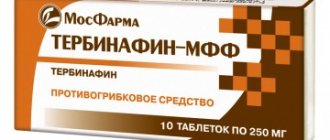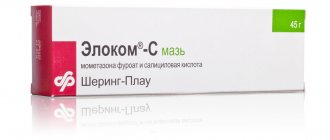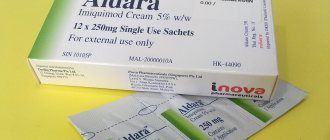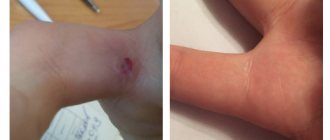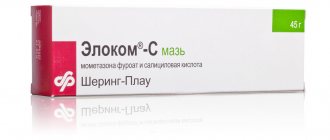Pharmacodynamics and pharmacokinetics
Pharmacodynamics
“Betamethasone – what is it?” - a common question when using betamethasone-containing drugs . Betamethasone is a glucocorticosteroid . It blocks the migration of leukocytes, the release of lysosomal enzymes and anti-inflammatory mediators in the area of inflammation, suppresses phagocytosis , weakens vascular permeability, and stops the development of edema in the inflammatory focus.
Pharmacokinetics
When the cream is applied locally in therapeutic doses, percutaneous absorption into the blood is insignificantly 12-14%. Reaction with blood proteins – 64%. Transformed in the liver.
It is excreted through the kidneys mainly in the form of metabolites , a small part is excreted in bile. The presence of skin damage, inflammation, or the application of occlusive dressings improves the absorption of betamethasone.
pharmachologic effect
Betamethasone is a glucocorticosteroid for external use. It has anti-inflammatory, antipruritic, antiallergic, vasoconstrictive, antiexudative and antiproliferative effects. Inhibits the accumulation of leukocytes, the release of lysosomal enzymes and pro-inflammatory mediators at the site of inflammation, inhibits phagocytosis, reduces vascular tissue permeability, and prevents the formation of inflammatory edema. When applied to the surface of the skin, it has a quick and strong effect at the site of inflammation, reducing the severity of objective symptoms (erythema, swelling, lichenification) and subjective sensations (itching, irritation, pain).
Indications for use
- In order to reduce inflammatory phenomena in eczema and dermatitis , including photodermatitis , lichen planus , nodular prurigo , neurodermatitis , discoid lupus erythematosus, pretibial myxedema, necrobiosis lipoidica and erythroderma .
- For the treatment of psoriasis in the scalp and other types of psoriasis , except extensive plaque psoriasis .
Contraindications
This drug is prohibited for use in the presence of bacterial, fungal and viral skin lesions, skin symptoms of syphilis , tuberculosis , skin reactions after vaccination, perioral dermatitis , acne , perianal or genital itching, plaque psoriasis, rosacea, varicose veins . Also, the drug is not recommended for use in case of hypersensitivity to Betamethasone or other components of the drug.
How to take Betamethasone
Betamethasone should be taken exactly as prescribed by your doctor.
If you have any doubts about taking the drug, you should consult your doctor or pharmacist before use.
How to use Betamethasone
- Typically, Betamethasone should be used 1-2 times a day. Frequency of use may be reduced as skin condition improves
- Betamethasone is for use on the skin only.
- Do not exceed the prescribed dose of the drug
- Do not use Betamethasone on a large surface of the skin for a long time (every day for weeks or months) - unless, of course, your doctor has prescribed it for you
- Microorganisms can promote the development of infections in warm, moist conditions under dressings and bandages, so the skin should be cleaned before applying a new dressing.
- If you apply the ointment to someone else, wash your hands thoroughly before applying or wear disposable gloves.
- If your skin condition does not improve within 2-4 weeks, contact your doctor
How to use Betamethasone ointment
- Wash your hands.
- Apply a thin layer of ointment to the affected areas of the skin and lightly rub it into the skin until completely absorbed. You can dose Betamethasone by applying it to your fingertip. When dosing children, use less ointment, but still use an adult's finger as a dosing unit.
This picture shows the dosage unit - 1 Fingertip Unit (FTU).
FingerTip Unit - the amount of ointment from a tube with a hole diameter of 5 mm, covering the distal phalanx of the index finger of an adult.
- After applying the ointment, rinse your hands thoroughly, except in cases where the skin of the hands is affected and is the area for applying the ointment.
Dosage for adults
Don't worry if you use a little more or less ointment than you should, it will only be unevenly distributed.
Dosage for children from 1 to 10 years
| Required number of FTU units | |||||
| Children's age | Face and neck | Hand and bone | Leg and foot | Front Part torso | Rear Part , _ including buttocks |
| 1-2 years | 1,5 | 1,5 | 2 | 2 | 3 |
| 3-5 years | 1,5 | 2 | 3 | 3 | 3,5 |
| 6-10 years | 2 | 2,5 | 4,5 | 3,5 | 5 |
- Cannot be used by children under 1 year of age
- For children it is especially important not to exceed the prescribed dose
- The course of treatment for children should not exceed 5 days - unless your doctor has prescribed a longer course of treatment
If you have psoriasis
If you have severe psoriatic plaques on your elbows or knees, your doctor may recommend applying ointment under sealed occlusive dressings. However, this is recommended when using the ointment at night to enhance its effect. After a short period of time, you need to return to your normal regimen of taking the ointment.
If you use Betamethasone on the facial skin
You can apply Betamethasone ointment on your face if your doctor has prescribed it for you. It is not recommended to use Betamethasone for more than 5 days, as longer use leads to thinning of the skin. Avoid getting Betamethasone in the eye.
If you use more Betamethasone than recommended
If you have used too much ointment or accidentally swallowed it, contact your doctor or the nearest hospital emergency room immediately.
If you forget to take Betamethasone
If you forget to take the next dose of the drug, take it as soon as you remember. Then continue using as usual.
If you stop taking Betamethasone
If you are using Betamethasone regularly and want to stop taking it, you should talk to your doctor before you stop using this drug as your condition may get worse if you suddenly stop taking the drug.
If you have any additional questions, you should immediately contact your doctor or pharmacist.
Possible side effects
Like other medicines, Betamethasone can cause side effects, although not everyone gets them.
Stop using Betamethasone and tell your doctor immediately if:
- You will find that your skin gets worse, you develop a generalized rash, or your skin swells during treatment. You may be allergic to Betamethasone, have an infection, or need other treatment
- You have psoriasis and there are raised bumps of pus under the skin. This may occur very rarely during or after treatment and is known as pustular psoriasis.
Other side effects
Common ( may affect 1 in 10 )
- burning sensations, pain, irritation or itching at the sites where the ointment is applied.
Very rare (may affect up to 1 in 10,000)
- increased risk of developing infection
- allergic skin reaction where the ointment is applied
- rash, itching, bumpiness, or redness of the skin
- thinning and dryness of the skin, as well as increased susceptibility to damage and wrinkling
- development of stretch marks
- veins beneath the surface of your skin may become more visible
- increase or decrease in hair growth or hair loss and changes in skin color
- weight gain, rounding of the face
- delayed weight gain or slowed growth in children
- thinning, weakening and increased susceptibility to bone fractures
- development of cataracts or glaucoma
- elevated levels of sugar in the blood or urine
- increased blood pressure
Reporting Adverse Events:
If you notice any side effects, tell your doctor, pharmacist or nurse. This includes any side effects not listed in this leaflet. You can also report side effects directly to the Scientific Center for Expertise of Medicines and Medical Technologies. Academician E. Gabrielyan, go to the website www.pharm.am to the section “Report a side effect of a drug” and fill out the form “Card for reporting a side effect of a drug.” Hotline phone: +37410237665; +37498773368. By reporting side effects, you can help provide more information about the safety of this drug.
How to store Betamethasone
- Store out of reach of children, in a dry place, protected from light at a temperature not exceeding 15º C
- Shelf life – 3 years. Shelf life after first opening the tube – 6 months
Do not take Betamethasone after the expiration date indicated on the drug package. When indicating the expiration date, we mean the last day of the specified month.
Medicines should not be disposed of in wastewater or sewer systems. Ask your pharmacist how to dispose of any medicine you no longer need. These measures are aimed at protecting the environment.
Package contents and additional information
What Betamethasone contains
Active substance: betamethasone (in the form of valerate) – 1 mg;
Other components: liquid paraffin, propylparaben (E216), white petrolatum, ethyl alcohol
What Betamethasone looks like and contents of the pack:
Ointment is white to yellowish-white, odorless
Description of packaging
0.1% ointment for external use in an aluminum tube of 15g along with a leaflet in a cardboard pack.
Vacation conditions
Available with prescription
Side effects
- Skin reactions: with prolonged treatment, sensations of itching , burning, dryness, and irritation may occur at the site of frequent use of the drug. , folliculitis, acne, hypertrichosis, hypopigmentation, perioral dermatitis, hyperpigmentation, contact dermatitis, secondary infection, skin maceration, skin atrophy, miliaria, stretch marks and develop .
- Systemic reactions: Itsenko-Cushing syndrome , decreased tolerance to carbohydrates, suppression of adrenal function. In children, suppression of adrenal function is manifested by increased intracranial pressure, growth retardation, decreased body weight, decreased cortisol in the blood, bulging fontanel, headache and swelling of the optic nerve.
GLUCOCORTICOID DRUGS
Toolkit
| Content | ||
| Preface Introduction Pharmacodynamics Pharmacokinetics | Adverse reactions General indications for use Contraindications Characteristics of drugs | Principles of long-term therapy Chronotherapeutic approach Alternating therapy Pulse therapy |
| Peculiarities of use in certain diseases Peculiarities of use in pregnant and lactating women Local application Inhalation administration Intra- and periarticular administration | Application in dermatology Application in ophthalmology and otorhinolaryngology References | |
Betamethasone cream and ointment, instructions for use (Method and dosage)
The cream is used locally. The drug dosage regimen is developed individually.
The cream should be applied to the affected area of the skin in a thin layer twice a day, gently rubbing. After signs of improvement appear, the frequency of use can be reduced to once a day. The duration of treatment is determined by the speed of disappearance of the inflammatory process, cleansing of the skin and cessation of itching. Also, the duration of the course of therapy depends on the severity and type of disease. Usually the course of treatment lasts 1-2 weeks. There should be a break of at least three weeks between repeated treatment cycles.
The course of therapy in children and patients with facial skin lesions is no more than 5 days.
special instructions
The drug is not used in ophthalmology. Do not allow the drug to come into contact with the eyes or skin of the eyelids, as this can lead to the development of cataracts, glaucoma , fungal and herpetic infections.
In patients with psoriasis , the use of Betamethasone may worsen the course of this disease.
The armpits and groin area are more prone to stretch marks . The use of the product in these areas should not be prolonged.
When superinfection additional use of antifungal or antibacterial drugs , depending on the etiology.
It is not recommended to use the cream on the scalp.
Betamethasone
GCS inhibits the release of interleukin1, interleukin2, interferon gamma from lymphocytes and macrophages. It has anti-inflammatory, antiallergic, desensitizing, antishock, antitoxic and immunosuppressive effects.
Suppresses the release of ACTH and beta-lipotropin by the pituitary gland, but does not reduce the content of circulating beta-endorphin. Inhibits the secretion of TSH and FSH.
Increases the excitability of the central nervous system, reduces the number of lymphocytes and eosinophils, increases the number of red blood cells (stimulates the production of erythropoietin).
Interacts with specific cytoplasmic receptors and forms a complex that penetrates the cell nucleus and stimulates the synthesis of mRNA; the latter induces the formation of proteins, incl. lipocortin, mediating cellular effects. Lipocortin inhibits phospholipase A2, suppresses the release of arachidonic acid and suppresses the synthesis of endoperoxides, Pg, leukotrienes, which contribute to inflammation, allergies, etc.
Protein metabolism: reduces the amount of protein in plasma (due to globulins) with an increase in the albumin/globulin ratio, increases the synthesis of albumins in the liver and kidneys; enhances protein catabolism in muscle tissue.
Lipid metabolism: increases the synthesis of higher fatty acids and TG, redistributes fat (fat accumulation mainly in the shoulder girdle, face, abdomen), leads to the development of hypercholesterolemia.
Carbohydrate metabolism: increases the absorption of carbohydrates from the gastrointestinal tract; increases the activity of glucose-6-phosphatase, leading to an increase in the flow of glucose from the liver into the blood; increases the activity of phosphoenolpyruvate carboxylase and the synthesis of aminotransferases, leading to the activation of gluconeogenesis.
Water-electrolyte metabolism: retains Na+ and water in the body, stimulates the excretion of K+ (MCS activity), reduces the absorption of Ca2+ from the gastrointestinal tract, “washes out” Ca2+ from the bones, increases the excretion of Ca2+ by the kidneys.
The anti-inflammatory effect is associated with inhibition of the release of inflammatory mediators by eosinophils; inducing the formation of lipocortin and reducing the number of mast cells that produce hyaluronic acid; with a decrease in capillary permeability; stabilization of cell membranes and organelle membranes (especially lysosomal ones).
The antiallergic effect develops as a result of suppression of the synthesis and secretion of allergy mediators, inhibition of the release of histamine and other biologically active substances from sensitized mast cells and basophils, T- and B-lymphocytes, mast cells, decreased sensitivity of effector cells to allergy mediators, inhibition of antibody formation, changes the body's immune response.
In COPD, the action is based mainly on inhibition of inflammatory processes, inhibition of development or prevention of swelling of the mucous membranes, inhibition of eosinophilic infiltration of the submucosal layer of the bronchial epithelium, deposition of circulating immune complexes in the bronchial mucosa, as well as inhibition of erosion and desquamation of the mucous membrane. Increases the sensitivity of beta-adrenergic receptors of small and medium-caliber bronchi to endogenous catecholamines and exogenous sympathomimetics, reduces the viscosity of mucus by inhibiting or reducing its production.
Antishock and antitoxic effects are associated with an increase in blood pressure (due to an increase in the concentration of circulating catecholamines and restoration of the sensitivity of adrenergic receptors to them, as well as vasoconstriction), a decrease in the permeability of the vascular wall, membrane protective properties, and activation of liver enzymes involved in the metabolism of endo- and xenobiotics.
The immunosuppressive effect is due to inhibition of the release of cytokines (interleukin1, interleukin2; interferon gamma) from lymphocytes and macrophages.
Suppresses the synthesis and secretion of ACTH and, secondarily, the synthesis of endogenous corticosteroids. Inhibits connective tissue reactions during the inflammatory process and reduces the possibility of scar tissue formation.
The drug is an easily soluble compound that is well absorbed after parenteral administration into tissues and provides a rapid effect. The drug has slower absorption. By combining these salts it is possible to create drugs with both short-term (but rapid) and long-term effects. Depending on the method of application (IV, IM, intra-articular, periarticular, IV), a general or local effect is achieved.
Analogs
Level 4 ATC code matches:
Gistan-N
Sinalar
Avecourt
Mesoderm
Momederm
Betazon
Silkaren
Elokom
Flucinar
Sinaflan
Celestoderm
Cutivate
Advantan
Beloderm
Mometasone Furoate
Uniderm
Momat
Betamethasone analogs: Akriderm, Betazon, Beloderm Express, Betamethasone valerate, Betliben, Betamethasone dipropionate, Soderm, Celestoderm-V.
Betamethasone price, where to buy
The price of Betamethasone ointment in Russia starts from 115 rubles, in Ukraine the price averages 20-23 hryvnia.
- Online pharmacies in RussiaRussia
- Online pharmacies in UkraineUkraine
ZdravCity
- Betamethasone-Vertex ointment for external use 0.05% 30gVertex AO RUB
160 order - Betamethasone-Vertex cream for external use 0.05% tube 30gVertex AO
162 RUR order
show more
Pharmacy24
- Betamethasone-Darnitsa 15g cream PrAT" Pharmaceutical company "Darnitsa", Ukraine
32 UAH. order - Betamethasone 15 g cream PAT "Kievmedpreparat", Ukraine
31 UAH order
